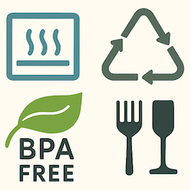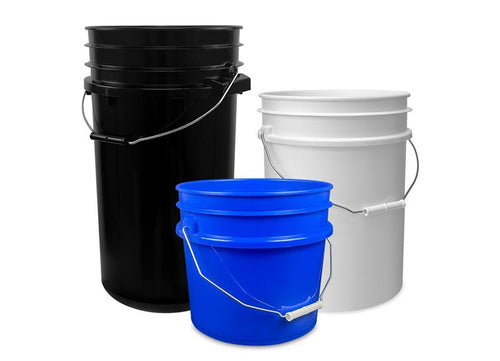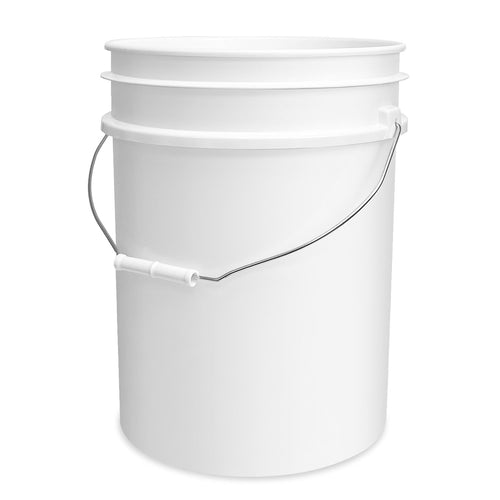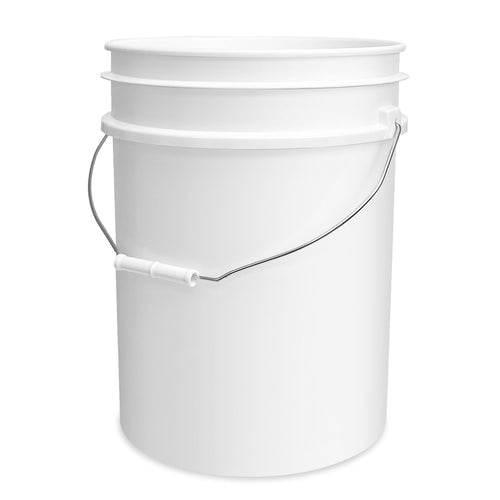As a business relying on plastic packaging, you know it's more than just a container. It's a critical component of your product's safety, shelf life, and appeal. You've likely encountered a multitude of symbols, numbers, and icons stamped onto plastic containers – from those used for your food products to industrial supplies. These aren't random markings; they're vital messages from manufacturers, designed to convey crucial information about the packaging itself.
At ePackageSupply, we believe in empowering our customers with comprehensive knowledge. Understanding these plastic packaging logos and icons is essential for making informed decisions about product safety, ensuring proper usage, streamlining recycling processes, and aligning with your environmental responsibility goals.
Think of this as your decoder guide for plastic packaging. Let's demystify these symbols, one icon at a time.
📋 Table of Contents (Click to Expand)
Safety & Regulatory Icons: What's Safe for Your Product & You?
These symbols tell you about the safety standards the plastic meets, especially concerning food contact and chemical composition.
1. FDA-Approved / Food-Safe
![]()
• What it looks like: While there isn't one single, universal "FDA-Approved" logo that appears directly on consumer packaging, the concept of "Food-Safe" is often conveyed through other symbols or implicit claims. Sometimes you'll see a fork and glass symbol.
• What it means: This indicates that the plastic material has been deemed safe for direct contact with food products by regulatory bodies like the U.S. Food and Drug Administration (FDA). It means the material won't leach harmful chemicals into food under normal conditions of use.
• Where you'll see it: Most commonly on food storage containers, deli containers, yogurt cups, beverage bottles, and plastic cutlery.
• Important Note: "FDA-approved" means the material is safe for contact, not necessarily that the final product has been reviewed by the FDA. Always refer to official FDA guidelines for specific regulations.
2. BPA-Free
![]()
• What it looks like: Often a text-based label saying "BPA-Free," sometimes accompanied by a small leaf or a circle with a diagonal line through "BPA."
• What it means: Bisphenol A (BPA) is an industrial chemical that has been used to make certain plastics and resins since the 1950s. Concerns have been raised about its potential health effects, particularly in infants and young children. A "BPA-Free" label signifies that the product is made without this chemical.
• Where you'll see it: Baby bottles, children's sippy cups, food storage containers, and increasingly on a wide range of plastic consumer goods.
Usage Instruction Icons: How to Use Your Packaging Correctly
These symbols provide essential guidelines for how to safely use and care for the plastic packaging in various environments.
1. Microwave-Safe
![]()
• What it looks like: A symbol resembling a microwave oven with wavy lines inside, or sometimes just wavy lines.
• What it means: This icon indicates that the plastic container is designed to safely withstand microwave heating without melting, warping, or leaching harmful chemicals into your food. Plastics without this symbol can deform or become unsafe when microwaved.
• Where you'll see it: Meal prep containers, frozen meal trays, disposable food containers, and reusable food storage tubs.
• Tip: Even if marked "microwave-safe," avoid prolonged heating of oily or sugary foods, as these can reach very high temperatures and potentially damage the plastic.
2. Freezer-Safe
![]()
• What it looks like: A symbol resembling a snowflake or a stylized image of a freezer.
• What it means: This means the plastic material is designed to withstand freezing temperatures without becoming brittle, cracking, or losing its structural integrity. It ensures your food stays protected in the freezer.
• Where you'll see it: Freezer bags, ice cream tubs, frozen food packaging, and specific food storage containers designed for freezing.
3. Dishwasher-Safe
![]()
• What it looks like: A symbol often showing a dishwasher machine with plates and/or water droplets. Sometimes it specifies "top rack only."
• What it means: This indicates that the plastic item can safely endure the high temperatures and harsh detergents of a dishwasher cycle without warping, fading, or degrading. If not marked "dishwasher-safe," hand washing is recommended.
• Where you'll see it: Reusable food containers, water bottles, and plastic dinnerware.
• Note: "Top rack only" means the plastic should only be placed on the upper rack of the dishwasher, where temperatures are generally lower and the drying element is further away.
Plastic Types & Resin Codes: The Recycling Symbols (#1–#7)
These are arguably the most common, yet often misunderstood, symbols on packaging. The chasing arrows triangle with a number inside identifies the type of plastic resin used to make the product. This helps recycling facilities sort materials correctly.
Quick Reference: Plastic Resin Codes
| Code | Material | Common Uses | Recyclability |
|---|---|---|---|
| #1 PET | Polyethylene Terephthalate | Water bottles, soda bottles, food jars | ✓ Widely accepted |
| #2 HDPE | High-Density Polyethylene | Milk jugs, detergent bottles, shampoo bottles | ✓ Widely accepted |
| #3 PVC | Polyvinyl Chloride | Blister packaging, some food wraps | ✗ Rarely accepted |
| #4 LDPE | Low-Density Polyethylene | Plastic bags, bread bags, squeeze bottles | ⚠ Store drop-off only |
| #5 PP | Polypropylene | Yogurt cups, deli containers, bottle caps | ⚠ Check locally |
| #6 PS | Polystyrene | Disposable plates, takeout containers, egg cartons | ✗ Not accepted |
| #7 OTHER | Mixed/Other Plastics | Multi-layer packaging, some water bottles | ✗ Rarely accepted |
1. #1 PET or PETE (Polyethylene Terephthalate)
![]()
• What it looks like: The chasing arrows symbol with a "1" in the center and "PET" or "PETE" underneath.
• What it means: This is a clear, strong, and lightweight plastic commonly used for beverages and food. It's highly recyclable.
• Where you'll see it: Soft drink bottles, water bottles, salad dressing containers, peanut butter jars, and some ready-meal trays.
• Recyclability: Widely accepted in curbside recycling programs.
2. #2 HDPE (High-Density Polyethylene)
![]()
• What it looks like: The chasing arrows symbol with a "2" in the center and "HDPE" underneath.
• What it means: A versatile plastic known for its strength-to-density ratio. It's opaque and highly durable.
• Where you'll see it: Milk jugs, detergent bottles, shampoo bottles, motor oil bottles, and some plastic bags.
• Recyclability: Widely accepted and highly recyclable in curbside programs.
3. #3 PVC (Polyvinyl Chloride)
![]()
• What it looks like: The chasing arrows symbol with a "3" in the center and "PVC" underneath.
• What it means: A rigid or flexible plastic with many uses, but concerns about its environmental impact have led to reduced use in packaging.
• Where you'll see it: Blister packaging (e.g., for pills, small electronics), some food wraps, window frames, and plumbing pipes.
• Recyclability: Less commonly accepted in curbside recycling due to challenges in sorting and potential environmental concerns during recycling. Check local recycling guidelines.
4. #4 LDPE (Low-Density Polyethylene)
![]()
• What it looks like: The chasing arrows symbol with a "4" in the center and "LDPE" underneath.
• What it means: A flexible, tough, and transparent plastic.
• Where you'll see it: Plastic shopping bags, bread bags, dry cleaning bags, squeeze bottles, and some food storage container lids.
• Recyclability: Not commonly accepted in curbside recycling bins, but often collected at store drop-off points for plastic bags and films.
5. #5 PP (Polypropylene)
![]()
• What it looks like: The chasing arrows symbol with a "5" in the center and "PP" underneath.
• What it means: A tough, heat-resistant, and chemically resistant plastic.
• Where you'll see it: Yogurt cups, margarine tubs, deli containers, medicine bottles, bottle caps, and some reusable food containers.
• Recyclability: Increasingly accepted in curbside recycling, but acceptance can vary by region.
6. #6 PS (Polystyrene)
![]()
• What it looks like: The chasing arrows symbol with a "6" in the center and "PS" underneath.
• What it means: Can be rigid (e.g., plastic cutlery) or foamed (Styrofoam). Lightweight but can be brittle.
• Where you'll see it: Disposable plates and cups, take-out containers, egg cartons, and protective foam packaging.
• Recyclability: Generally not accepted in curbside recycling due to its light weight, bulkiness, and potential for contamination. Some specialized recycling centers may accept it.
7. #7 OTHER (All Other Plastics)
![]()
• What it looks like: The chasing arrows symbol with a "7" in the center and "OTHER" or "O" (or sometimes just a blank space) underneath.
• What it means: This category includes all other plastic resins not covered by numbers 1-6, as well as multi-material plastics (e.g., bioplastics, polycarbonate, acrylic).
• Where you'll see it: Certain food containers (e.g., five-gallon water bottles), multi-layer packaging, eyeglasses, DVDs, and some specialized plastic parts.
• Recyclability: Rarely accepted in curbside recycling programs. Check with specialty recyclers.
Sustainability & Other Environmental Marks
These icons signify a commitment to environmental practices, often related to end-of-life options beyond traditional recycling.
1. Recyclable (General)
![]()
• What it looks like: The universal chasing arrows symbol (often without a number inside), indicating that the material can be recycled.
• What it means: This symbol means the material is capable of being recycled, but it doesn't guarantee that local facilities will accept it or that an infrastructure exists. It's a statement about the material's potential.
• Where you'll see it: Widely on packaging materials, including plastics, paperboard, glass, and metal.
2. Compostable
![]()
• What it looks like: Often a stylized leaf, a compost pile, or a circle with "COMPOSTABLE" text. Look for certifications like the BPI (Biodegradable Products Institute) logo.
• What it means: This indicates that the material will break down into organic matter (like soil) in a specific composting environment. There are two main types:
- Industrial/Commercial Compostable: Requires specific conditions (high heat, controlled moisture) found in commercial composting facilities. This is the most common type for packaging.
- Home Compostable: Designed to break down in a typical backyard compost pile, though these are less common for packaging.
• Where you'll see it: Bioplastic cutlery, produce bags, some food service containers made from plant-based materials.
• Important Note: "Compostable" is not the same as "Biodegradable" (see below). Always check if a commercial composting facility is available in your area before disposing of compostable packaging.
3. Biodegradable
![]()
• What it looks like: Often a leaf, an arrow, or a circle with "BIODEGRADABLE" text.
• What it means: This term means the material will break down into simpler substances (like water, carbon dioxide, biomass) over time due to the action of microorganisms. However, it does not specify the timeframe, conditions (e.g., soil, water, air), or whether it leaves behind any toxic residue.
• Where you'll see it: Sometimes on plastic bags, or certain disposable items.
• Important Note: This term is often criticized for being vague and potentially misleading, as many "biodegradable" plastics might only break down in specific industrial conditions that aren't widely available. It's not a substitute for "Compostable" or "Recyclable."
4. "Green" Certifications & Logos
• What they look like: These vary widely, but often feature stylized leaves, globes, or specific organization logos. Examples include:
-
How2Recycle: A standardized U.S. label that clearly tells consumers how to recycle each component of a package (e.g., "Recycle Bottle," "Store Drop-off Plastic Bag").

-
FSC (Forest Stewardship Council): For paperboard components of packaging, indicating responsibly managed forests.

-
Cradle to Cradle Certified: A multi-attribute standard for products that are safe, circular, and responsibly made.

• What they mean: These logos are third-party certifications that verify specific environmental claims or sustainable practices related to the material, manufacturing process, or end-of-life management of the packaging. They offer a higher level of credibility than self-declared claims.
• Where you'll see them: On a variety of packaging types, including plastic components, paperboard, and full packaging systems.
• Tip: If you see a "green" logo you don't recognize, a quick online search for the organization behind it can help you understand its specific meaning and criteria.
From Symbol to Strategy: Understanding Your Packaging's Journey
Understanding these plastic packaging logos and icons transforms your business from a passive recipient of materials into an informed decision-maker. At ePackageSupply, our commitment extends beyond providing high-quality packaging; we're dedicated to equipping you with the knowledge to utilize it responsibly.
By paying close attention to these symbols, you can ensure the safety and compliance of your products, optimize the usage and lifespan of your packaging, and contribute meaningfully to recycling efforts and a more sustainable circular economy.
Still have questions about the right plastic packaging for your product, or want to discuss sustainable options? Contact us today! We're here to help you make smart, responsible choices for your business.
Frequently Asked Questions (FAQs)
Q: What do the numbers on plastic containers mean?
A: The numbers (1 through 7) inside the chasing arrows symbol, known as the Resin Identification Code (RIC), identify the specific type of plastic resin used to make the product. This code helps recycling facilities sort materials correctly.
Q: Can biodegradable plastic go in the recycling bin?
A: Generally, no. Biodegradable plastics are designed to break down into simpler substances due to microorganisms over time, but this doesn't guarantee they will break down in recycling facilities or that they won't contaminate traditional recycling streams. They are not a substitute for compostable or recyclable plastics.
Q: What does "FDA-Approved" mean for plastic packaging?
A: For plastic packaging, "FDA-approved" means the plastic material has been deemed safe by the U.S. Food and Drug Administration (FDA) for direct contact with food products. It indicates the material won't leach harmful chemicals into food under normal use, though it doesn't mean the final product itself has been reviewed by the FDA.
Q: Is "Compostable" the same as "Biodegradable"?
A: No, they are not the same. "Compostable" means the material will break down into organic matter in a specific composting environment (industrial or home) within a set timeframe. "Biodegradable" means it will break down over time, but it doesn't specify the timeframe, conditions, or whether it leaves toxic residue. Compostable materials are a more specific subset of biodegradable ones.
Q: Can all plastics with the chasing arrows symbol be recycled curbside?
A: Not necessarily. While the chasing arrows symbol indicates the type of plastic resin used and its potential to be recycled, it doesn't guarantee that your local recycling facility will accept it or that the necessary infrastructure exists for that specific plastic type in your area. Always check local recycling guidelines.
Q: Why is it important to know if plastic is "Microwave-Safe" or "Freezer-Safe"?
A: These symbols are crucial for safe usage. "Microwave-Safe" means the plastic can withstand heating without melting, warping, or leaching chemicals. "Freezer-Safe" means it won't become brittle, crack, or lose integrity in freezing temperatures, ensuring product protection. Using non-marked plastics in these environments can be unsafe or damage the container.
Q: Can you microwave plastic with recycling code 5?
A: Yes, plastic with recycling code 5 (PP/Polypropylene) is generally microwave-safe due to its heat-resistant properties. However, always check for the microwave-safe symbol to be certain, as not all #5 plastics are designed for microwave use. Polypropylene can typically withstand temperatures up to 230°F (110°C).
Q: What plastic numbers should you avoid for food storage?
A: Avoid plastics #3 (PVC), #6 (PS), and #7 (OTHER) for food storage. PVC can contain harmful additives, polystyrene can leach styrene, and #7 plastics may contain BPA or other concerning chemicals. Stick to #1 (PET), #2 (HDPE), #4 (LDPE), and #5 (PP) for safer food storage options.
Q: How can I tell if plastic packaging is actually recyclable in my area?
A: Check your local recycling program's website or contact them directly. Look for the resin code (1-7) on the plastic and compare it to your area's accepted materials list. Many municipalities only accept #1 and #2 plastics, while others may accept additional types. The How2Recycle label also provides specific recycling instructions.
Q: What's the difference between industrial compostable and home compostable plastic?
A: Industrial compostable plastics require high temperatures (140°F+) and controlled conditions found only in commercial facilities to break down within 90-180 days. Home compostable plastics can decompose in backyard compost bins at lower temperatures within 6-12 months. Most compostable packaging is industrial-only, so check for specific certifications like "OK Compost HOME."
Common Misunderstandings About Plastic Symbols
Despite their widespread use, plastic packaging symbols are often misunderstood. Clarifying these common misconceptions can help you make truly informed decisions:
-
"The chasing arrows always mean recyclable." → False.
While the chasing arrows symbol indicates the type of plastic resin used and its potential to be recycled, it doesn't guarantee that local facilities will accept it or that the necessary infrastructure exists for that specific plastic type in your area. The number inside the triangle (1-7) identifies the specific plastic, and local guidelines must be checked. -
"BPA-Free means the product is totally safe." → Not necessarily.
A "BPA-Free" label signifies that the product is made without Bisphenol A (BPA). However, the label does not inherently guarantee the absence of all other potential chemicals or contaminants. -
"Biodegradable means it can go in backyard compost."
Not without proper certification, and even then, it's not the same as "compostable." The term "biodegradable" simply means a material will break down over time due to microorganisms, but it does not specify the timeframe, conditions (e.g., soil, water, air), or whether it leaves behind any toxic residue. Many "biodegradable" plastics might only break down in specific industrial conditions. "Compostable" is a more precise term that implies breakdown in a composting environment. -
"If a plastic doesn't have a specific usage symbol (like microwave-safe), it's probably fine to use it that way." → False.
The absence of a symbol like "Microwave-Safe" means the plastic container is not designed to safely withstand that use. Plastics without these specific markings can melt, warp, or potentially leach harmful chemicals into food when exposed to conditions they aren't intended for. -
"All #7 plastics are the same and cannot be recycled." → False.
The "#7 OTHER" category is a catch-all for all other plastic resins not covered by 1-6, including multi-material plastics and even some bioplastics. While rarely accepted in curbside recycling, some specialized recycling centers may accept specific types within this category. So, it's not universally non-recyclable, but it is the most difficult category to recycle.
Glossary of Terms
To help you fully understand the language of plastic packaging, here are some key terms used in this guide:
BPA (Bisphenol A): An industrial chemical that has been used to make certain plastics and resins, sometimes sparking health concerns and leading to "BPA-Free" labeling.
Biodegradable: Refers to materials that will break down into simpler substances due to microorganisms over time. This term does not specify the timeframe or conditions for breakdown.
Compostable: Indicates a material will break down into organic matter (like soil) within a specific timeframe and under defined conditions, typically in an industrial or home composting environment.
FDA (U.S. Food and Drug Administration): A regulatory body responsible for ensuring the safety of various products, including materials that come into contact with food.
HDPE (High-Density Polyethylene): A versatile, opaque, and highly durable plastic (#2) commonly used for items like milk jugs and detergent bottles.
LDPE (Low-Density Polyethylene): A flexible, tough, and transparent plastic (#4) often found in plastic bags and squeeze bottles.
PET/PETE (Polyethylene Terephthalate): A clear, strong, and lightweight plastic (#1) frequently used for beverage bottles and food containers.
PP (Polypropylene): A tough, heat-resistant, and chemically resistant plastic (#5) common in yogurt cups and deli containers.
PS (Polystyrene): A plastic (#6) that can be rigid (like cutlery) or foamed (like egg cartons).
PVC (Polyvinyl Chloride): A rigid or flexible plastic (#3) used in some blister packaging and food wraps, often facing environmental concerns.
Recyclable: Indicates that a material has the potential to be recycled, though specific local facilities may or may not accept it.
Resin Identification Code (RIC): The universal recycling symbol (chasing arrows) with a number (1–7) inside, identifying the specific type of plastic polymer.
Regional Recycling Resources
Recycling guidelines vary significantly by location. Check with your local recycling program to understand which plastic types are accepted in your area:
National Resources:
- Earth911 Recycling Search - Enter your ZIP code to find local recycling options for specific materials
- How2Recycle Store Drop-Off Directory - Find locations accepting plastic bags and films (#4 LDPE)
- EPA Recycling Resources - Federal guidelines and educational materials
Major City Recycling Programs:
- New York City: NYC Department of Sanitation
- Los Angeles: LA Sanitation & Environment
- Chicago: Chicago Recycling Guide
- Houston: Houston Solid Waste Management
- Phoenix: Phoenix Public Works Recycling
State-Level Resources:
- California: CalRecycle Plastic Recycling
- Texas: TCEQ Recycling Resources
- Florida: Florida DEP Recycling
- Oregon: Oregon DEQ Recycling Info
- Michigan: Michigan EGLE Recycling
💡 Pro Tip: Many grocery stores and retailers have collection bins for plastic bags and films that aren't accepted in curbside recycling. Look for these bins near store entrances to properly recycle #4 LDPE plastics.
Need BPA-Free, Recyclable or Compostable Packaging?
Explore containers and bottles that meet today's safety and sustainability standards.

 Violet Zhang
Violet Zhang
















































